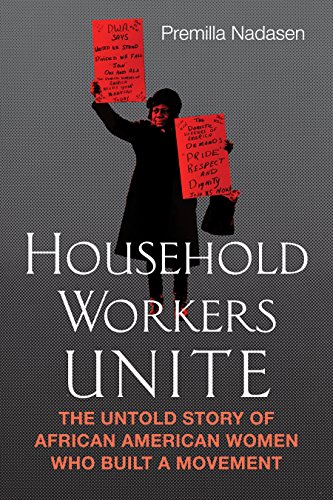Small-sized reviews, raves, and recommendations.

One of the greatest challenges to forming a union is communication. When forces combine to make a labor sector invisible, it becomes imperative to create situations where workers can collaborate and negotiate with management and each other. It should come as no surprise that American labor history has been dominated by narratives about men and centered on the factory floor. In the case of the household domestic servant, race, gender, and space conspired to make this labor cohort invisible. Even the very name of their occupation became a matter of contention: domestic servant contra household worker. Household Workers Unite, by Premilla Nadasen is an important work of revisionist labor history. It focuses on the African American women who had been invisible to both American labor history and the American labor movement in general.
Nadasen offers biographies of important personalities within the household worker movement. She also goes on to explain how domestic workers were shunted off and forgotten within the larger narratives of labor history. It is a history fraught with contradictions and atomization. Since domestics worked, usually by themselves, in a family household, the struggle for labor rights had become that much more challenging. Added to this situation was the demographic handicap of being African American and a woman in the South. Nadasen’s work opens with the much ballyhooed news story about a New York City couple who treated their Southeast Asian domestic workers to torture and near-slave-like working conditions. The 2011 film, The Help, is rightfully criticized for its condescending use of the White Savior trope (this time the Southern woman narrator) inspiring her African American domestic servants to rise up against heinous working conditions. (Note: I have not seen the film and I don’t really want to. It makes Driving Miss Daisy sound like Malcolm X.) As Nadasen later illustrates, Southern women would go out and become politically active, yet not have a second thought about giving their African American domestic workers pay raises or decent hours. Even hazarding such suggestions to their white families could be grounds for immediate dismissal.
Domestic Workers Unite offers a comprehensive exploration of the African American domestic worker. It shows how the thorny issues of race, gender, and work barred these workers from advancements enjoyed by their male counterparts. She also shows how storytelling become a means of creating solidarity within the community of workers. For long decades, domestic workers were seen as the last frontier of the “non-unionizable” labor in the United States. Yet through difficult struggles and the double-edged sword of racism and sexism, African American women were able to advance their cause, achieve better working conditions, better pay, and better hours. They eventually were able to achieve the leverage of collective bargaining despite the unique nature of their work. (Today home healthcare professionals face the same hurdles.) In its own strange way, Domestic Workers Unite can be seen as a lens to view the current health crisis within professional wrestling, a sport that treats their performers with a casual brutality, especially when it comes to medical bills and an anti-union history as cold-blooded as the Ford Motor Company. To state the obvious, people don’t their manufacturing jobs back, they want their union jobs back.

